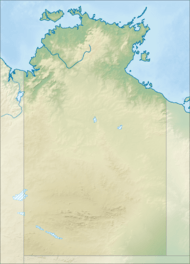Caranbirini Conservation Reserve facts for kids
Quick facts for kids Caranbirini Conservation ReserveNorthern Territory |
|
|---|---|
|
IUCN Category V (Protected Landscape/Seascape)
|
|
| Nearest town or city | Darwin |
| Established | 1996 |
| Area | 1,142 hectares (2,822 acres) |
| Managing authorities | Parks and Wildlife Commission of the Northern Territory |
| See also | Protected areas of the Northern Territory |
Caranbirini Conservation Reserve is a special protected area in the Northern Territory of Australia. It's a place where nature is kept safe and sound. This reserve is managed by the Parks and Wildlife Commission of the Northern Territory.
Contents
Discover Caranbirini Conservation Reserve
Caranbirini Conservation Reserve is a wonderful spot for exploring nature. It was officially set up in 1996 to protect its unique plants and animals. The reserve covers about 1,142 hectares (which is about 2,822 acres). That's a pretty big area to explore!
Where is Caranbirini Located?
This amazing reserve is found in the northern part of Australia. It is about 45 kilometers (28 miles) south of a town called Borroloola. If you're coming from Darwin, the capital city of the Northern Territory, it's much further away. Caranbirini is about 705 kilometers (438 miles) south-east of Darwin. You can easily get to the reserve by using the Carpentaria Highway.
What Makes Caranbirini Special?
Caranbirini Conservation Reserve is quite unique because it has many different types of natural areas, called habitats, all packed into a small space. Imagine walking through different landscapes in just one visit!
Diverse Landscapes and Habitats
You'll find tall sandstone hills and rocky ridges that look out over wide open woodlands. These woodlands are home to many different trees and plants. Near the water, you'll see special riverine vegetation. This means plants that love to grow close to water.
The Semi-Permanent Waterhole
One of the most important features of the reserve is its semi-permanent waterhole. "Semi-permanent" means it usually has water, but it might dry up during very dry seasons. This waterhole is a vital spot for many animals. They come here to drink, find food, and cool down. It's like a busy meeting place for wildlife!


